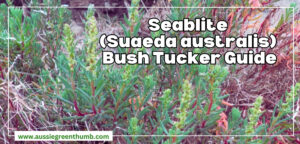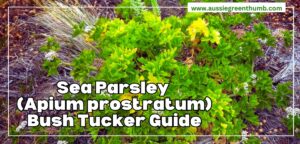Sea purslane is a rich source of omega-3 fatty acids that is generally used as a spinach substitute. The texture isn’t for everyone, but those who love it, really do swear by it.
This potentially diet-revolutionising vegetable is one of the easiest foods to grow at home, and comes back year after year, providing the whole family with edible greens, potentially all year round with indoor growing setups.
In this guide, we’ll talk a little about the different types of sea purslane, but thankfully the growing conditions for all of them are nearly identical, so once you’ve grown one you can experiment and grow the rest to try different textures and subtly different flavours.
Propagation is simple, but we offer tips on that right through to harvesting, and how to cook sea purslane.
More...
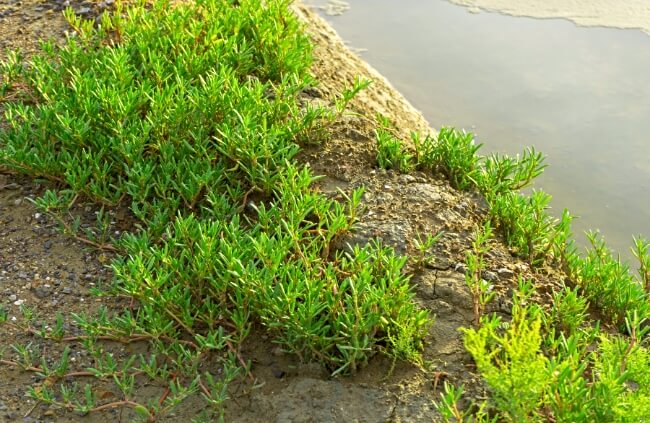
Family: | Aizoaceae |
|---|---|
Genus: | Sesuvium (and others) |
Species: | S. portulacastrum, S. maritimum |
Common name: | Sea purslane |
Origin: | Various native ranges |
Location: | Outdoor |
Type: | Trailing succulent, perennial herb |
Growth: | 1m spread |
Sun requirements: | Full sun |
Foliage colour: | Green or glaucous green |
Flower colour: | Pink |
Flowering: | Late summer |
Edible parts: | All parts are edible |
Maintenance level: | Low to medium |
Poisonous for pets: | Toxic to cats and dogs |
What is Sea Purslane?
Sea purslane is a general term applied to a group of three similar genera, Halimione, Honckenya, and Sesuvium. All three are coastal succulents with flowering growth and edible green foliage, and within the Sesuvium genus, there are numerous species, of which only eight are commonly cultivated.
They grow on short trailing vines, with succulent green leaves. Some species have glaucous leaves, typical of coastal plants, while others are vividly jade coloured.
The most suitable for culinary use are the less succulent types, as the more plump the leaves are the more mucilaginous the texture is – which can be quite off-putting even to fans of this healthy leafy green.
Sea purslane is also useful for coastal gardens, where rocky, gravelly or shale soils can be problematic. This is thanks to their deep root system, which seeks out water and helps to stabilise the rocky substrate it grows on as a result.
What is Sea Purslane’s Natural Habitat?
Sea purslane is a term that covers multiple genera, but the most commonly cultivated is Sesuvium portulacastrum. Its native range covers most of coastal North and South America, Africa, Asia, Australia and Hawaii.
Some species are specifically endemic to smaller parts of the globe, like Sesuvium edmonstonei, native to the Galapagos, or Halimione portulacoides, which seems to be restricted to the coasts of the Eurasian landmass.
In all cases, they grow on rocky, gritty or sandy substrates with high coastal exposure, and some are regularly submerged by tidal seawater.
They are regularly advised for coastal gardens as an informal ground cover because of their seeming indestructibility but can be cultivated in gardens and in containers with the right soil preparation and care.
Edible Uses & Identifying Sea Purslane
Sea purslane is easy to identify, but with so many variations across the world and amongst different genera, it's important to know exactly what you are looking for.
Sesuvium portulacastrum is the most common Australian native sea purslane, and has distinctively fleshy red stems, up to 1m long, covered in symmetrical pairs of grass-green, rounded leaves.


Get Your Free Guide:
Master Growing Australian Natives eBook
A Must Have Complete Guide for Every Australian Garden
Get Your Free Guide:
Master Growing Australian Natives eBook
A Must Have Complete Guide for Every Australian Garden
The leaves are succulent but quite flat and can reach up to 7cm long, though the young leaves are edible too. While in flower, they display subtle pink-purple star-shaped flowers with five petals, peeking out from behind the leaves. The flowers are also edible.
Common Uses for Sea Purslane
Sea purslane isn’t just a dinner table vegetable, it's also a useful plant for conservationists. Along Australian coastlines, and around the world, it is used to stabilise loose coastal earth, which supports wildlife habitats and helps other plants to get established without disturbance.
In coastal gardens, sea purslane is also a very useful ground cover plant, with Halimione portulacoides offering the most ornamental colours for that purpose.
The Most Common Sea Purslane Species for Cultivation
There are nine species of sea purslane that can be grown for edible uses, or sold for ornamental and horticultural display. They are all quite distinct from each other but grow in similar sites, and with similar flowers. Below, we’ll look briefly at each.
1. Halimione portulacoides
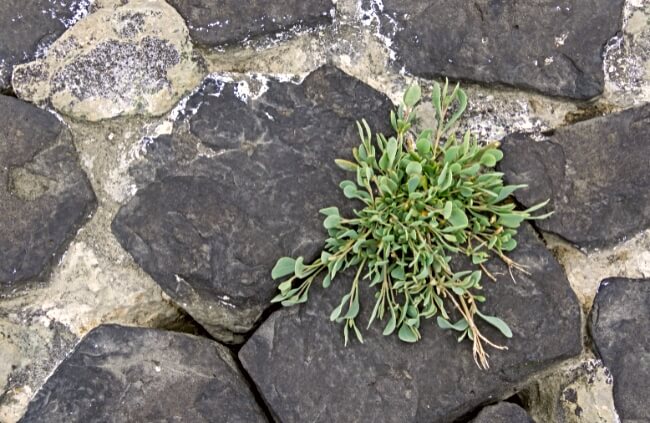
Found growing wild on shorelines across Europe and Asia, Halimione is most common in the Mediterranean and West Asian coasts. It grows similarly to perennial herbaceous sea purslanes but is actually a shrub, so will form tight mounds and grow in clumps up to 2m across.
Its silvery-blue leaves grow in pairs along arching stems that, when young, can be either pink or yellow. Its flowers are unlike other sea purslanes, growing from the stem as tight clusters of yellow or pink fleshy blooms, that stand above the rest of the plant.
2. Honckenya peploides

Also called sea sandwort, sea chickweed, or seaside sandplant, Honckenya peploides is the only species in its genus. It is a low-growing succulent perennial with leaves growing in alternate pairs, creating a tight structure up each stem.
They flower at the tips of each stem with unremarkable pea-like flowers with barely noticeable green petals. They can trail for up to 1m but are usually found as small trailing plants growing in sand, or on pebble beaches.
They are native to cooler coastal areas of Northern Europe, Asia and North America.
3. Sesuvium crithmoides
Tropical sea-purslane, or Sesuvium crithmoides, is an African native, found primarily on the coast of west Congo and west Angola. It is a very typical coastal plant, growing as a fleshy, succulent subshrub, with tiny white hairs on each silvery leaf that amplify its colour.
Fleshy pink stems, long, narrow leaves, and small pink flowers with white upright anthers make it relatively easy to identify.
4. Sesuvium edmonstonei
Galapagos carpet weed has some subspecies, all endemic to the Galapagos. Its leaves are rich, yellowy-green, elongated and glossy, developing on fleshy red stems with subtle scaling. In some conditions, it will appear bright red, in dense mounds on rocky shorelines, while young plants trail and spread.
White flowers with loose anthers stand above the rest of the foliage.
5. Sesuvium maritimum
Sesuvium maritimum, or slender sea-purslane, has unusual flowers for the genus, with rounded edges and quite vivid purple petals, backed by spiked leaves, usually with reddened tips.
The small spiky leaves behind each flower are not typical of the rest of the plant, which has quite wide, succulent leaves with visible pores. It is a low-growing shrub and forms excellent ground cover. Like most sea purslanes it can become a weed outside of its natural habitat.
6. Sesuvium microphyllum
The clue is in the name here, as Sesuvium microphyllum is the smallest of its genus, and has the smallest leaves. It can spread to about a foot in width, but it is usually restricted by the small pockets it grows in where it can find anchors in rocks.
It is not a particularly useful sea purslane for cultivation.
7. Sesuvium portulacastrum

Shoreline sea-purslane is the most common sea purslane, with the widest natural spread, covering much of Africa, South America and Australia as well as warmer parts of North America, Southern Europe and southern Asia.
Its flatter leaves make it a more pleasant addition to salads, as they are less mucilaginous than plumper sea purslanes. The foliage is similar in shape to jade, with elongated leaves that widen towards the top with neatly rounded tips.
Its stems can be green, yellow, red or woody, depending on age. This article focuses on growing techniques for Sesuvium portulacastrum, but tips can be applied to any of these varieties.
Note: Sesuvium sessile is a synonym for S. portulacastrum
8. Sesuvium trianthemoides
Texas sea-purslane is rare and possibly endangered, growing in a small range in Kennedy County, Texas. While you are unlikely to get hold of any to grow at home it is worth noting, because it evidences the ability of sea purslanes to grow in damper conditions.
Sesuvium trianthemoides grows solely in salt marshes, in damp depressions in sand dunes.
9. Sesuvium verrucosum
Like Texas sea-purslane, Sesuvium verrucosum can grow in consistently saline marshes, but it is also found growing in dry, alkaline, inland locations around the United States and South America.
The common name is western sea-purslane. Its flowers are deep purple, but typical in shape of other Sesuvium species, but its leaves are distinctively flat at their tip, with a fleshy grey-green colouring that looks like it has been dusted with castor sugar.
How to Grow Sea Purslane
Sea purslane will grow in extremely tough conditions, which, in theory, should make it very easy to grow. Our tendency to coddle and care for our plants can often get in the way though.
In this guide, we’ll run through how to set up the right conditions for growing this plant, including a few handy propagation tips. After that, it's all about gentle care, a light touch, and letting it do its own thing.
If it does start growing vigorously, the hardest thing will be managing its spread.

Ideal Conditions for Growing Sea Purslane
This growing guide focuses on Sesuvium portulacastrum, the native Australian sea purslane that grows all over our shores, but if you do want to try something different there are other non-native species you can grow in controlled settings too, using similar techniques.
Start with a bright spot in full sun, and prepare the ground so it is sandy, gravelly, and generally poor with excellent drainage.
It is particularly useful if you have a sloped, sandy, garden, as it can help to stabilise the soil and reduce erosion, and an essential ground cover for coastal gardens, but one of the best spots for it is a hanging basket, where it will manage its water supply with succulent leaves, and require watering far less frequently than other trailing pot plants.
Soil & Drainage
Ideal soil is a poor, gritty or sandy mix, but if grown in pots or hanging baskets add loamy soil or plenty of organic compost in so that there is some moisture retention.
Avoid growing it in boggy conditions, unless they are saline or alkaline sand bogs (rare in gardens, but worth noting for coastal gardeners).
Light & Shelter
Always plant sea purslane in full sun. It can cope with drought and hot summers, particularly if you plant native Sesuvium portulacastrum. This coastal plant needs no shelter from wind and is well adapted to coastal air.
The fine hairs on the leaves of some species, and open pores on others are adaptations to cope with these conditions.
Planting Sea Purslane
This plant has deep roots, which travel down into the earth to find water and nutrients. During droughts, it uses water reserves from its stems and leaves. There is no need to dig large holes or prepare the ground in advance other than to add grit to loam or clay soils.
Small cuttings or sections of sea purslane can be pushed into cracks in walls or into pebbly ground, and will often set roots. Once rooted it sends roots as deep as it needs to and can sprawl or develop into a wonderful mound.
Be careful not to damage the base of the plant when planting. Stems and leaves can recover if broken during planting, but the base and roots should be handled carefully when planting into walls.
How to Plant Sea Purslane in Pots
Planting in pots is always different to planting in the ground, regardless of the plant, because pots, hanging baskets and window boxes dry out faster. And if they are placed on hard standing there is nowhere for roots to grow towards in search of water.
When planting in pots, it is important to create a gritty compost mix, with plenty of drainage at the bottom of the pot. They need moisture retention from the compost, but should not be left in damp soil for too long.
After planting add a layer of grit or fine gravel to the surface of the pot to prevent soil splashing up onto the leaves, which can cause fungal issues.
How to Propagate Sea Purslane
Propagation is straightforward, but should always be done in late spring, late summer, or autumn (avoid early to mid-summer) when the temperatures are slightly cooler but it is still bright. It can be propagated from stem cuttings and seeds, and both are best done outdoors.
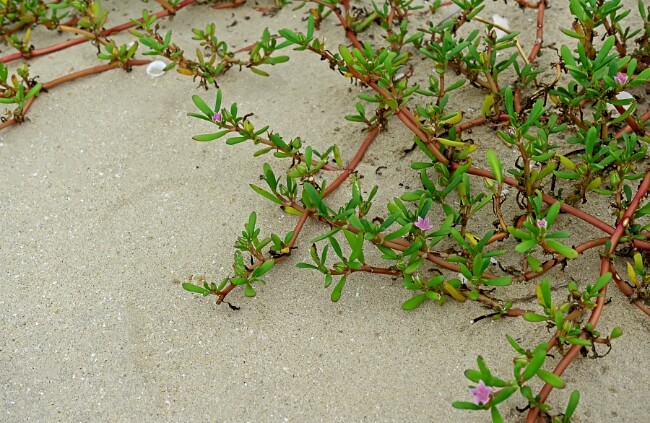
Propagating Sea Purslane from Seeds
Sow outdoors, in its final locations or container.
- For pot sowing - fill a pot with well-drained compost, or loamy soil mixed with plenty of grit, and sow onto the surface before covering it with a thin layer of grit.
- For sowing in the ground, make sure to choose a well-drained spot in full sun, and sow into 1cm deep drills before backfilling each channel. Water well after sowing, and then leave it to develop. Thin plants to 15cm apart once they are growing strongly.
Note: Sea purslane can be grown as an annual crop or perennial plant, depending on how often you harvest it. Mature plants can be harvested regularly, but young plants from seeds that are harvested more than occasionally will need resowing through the year to provide a good supply.
Sea Purslane Propagation from Cuttings
Cuttings are super easy to take and can be done in seed trays, pots, or directly into the ground where you want them to grow. They can also develop from layering by pinning the trailing stems into pots of gritty compost. When the stem roots, it can be cut from the parent and planted elsewhere.
My favourite way of taking sea purslane cuttings is the easiest, but least reliable. It involves taking stem cuttings in late spring or late summer, and inserting them directly, but gently, into cracks in walls. The purslane trails wonderfully and its roots are gentle so do no damage.
I have had a mixed success rate with this method, but when it works the effects are wonderful, and it's much easier than trying to squeeze a rooted plant into the same crack.
After inserting the cutting, mist it daily for the first few weeks, until you see signs of new growth. Water or mist it during droughts or dry weather for the first year, and then just leave it be.
Propagating from Division
And finally, the easiest and most foolproof way to propagate this plant is division. Mature plants will spread, and root from their stems when they find cracks. You will also find that self-seeded sea purslanes pop up close to their parents.
In both cases, you can simply dig up sections of the plant, or the young plants, and plant them elsewhere.
Caring for Sesuvium portulacastrum
Sea purslane needs very little care once established, and overfeeding can shock the plant and cause similar effects to overwatering. They will recover from droughts, even if they look completely dishevelled, so as a general rule, avoid feeding, mulching and watering mature sea purslane.
Pruning can be done from late spring to late summer while it is in its most active growth but isn’t necessary. To avoid unwanted spread, particularly if you are growing non-native varieties, deadheading flowers is important, but this can be a useful crop too as the flowers are edible.
Sea Purslane Pests and Diseases
Other than root rot, caused by overwatering or poor drainage, this plant is highly resistant to disease. If you notice yellow foliage, browning stems or any soft rot on the plant, check the soil moisture, and reduce watering.
Acidic soils are not friendly to sea purslane either, so consider some simple soil amendments like a light sprinkling of lime, which also adds calcium and magnesium to the soil – beneficial but not essential for sea purslane.
And other than common slugs and snails, this plant isn’t usually bothered by pests. Pick off slugs and snails when you see them if they are causing a lot of damage, or make a simple beer trap by filling a Tupperware with some cheap lager (cover it with something so that only slugs and snails can access the beer).
Harvesting & Storing Sea Purslane
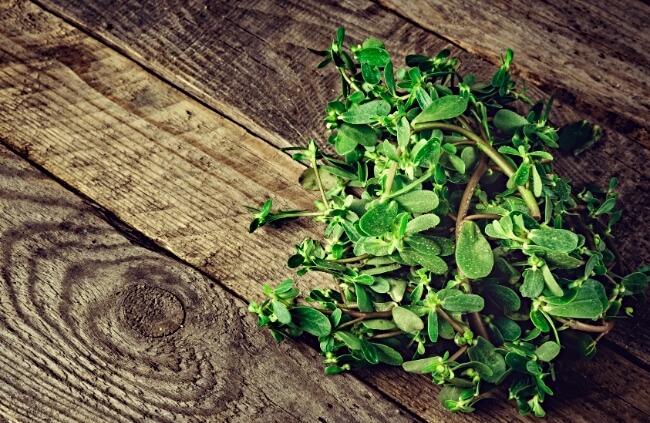
Sea purslane can be harvested as soon as it is in leaf, but leave it to bush out a bit first. The young leaves have a better texture and can be added to salads along with the stems.
Storing Sea Purslane
Sea purslane does not store well and any attempts to freeze it should be avoided because the texture of thawed sea purslane is one of the worst things you will ever experience.
The only way to eat it is fresh from the plant, and the sooner the better – but it will keep in the fridge for a few days.
How to Prepare Sea Purslane
Wild sea purslane tastes far superior to home-grown sea purslane. So foragers have the upper hand on us gardeners here. Young sea purslane, particularly thinner-leaved harvests, are wonderfully salty with a vague spinachy flavour.
If the leaves have plumped up more, they are best chopped up finely and added to sauces, which they will season, and slightly thicken.
Explore further bush tucker inspiration in our collection of bush tucker guides.
Sea Purslane Frequently Asked Questions
Is sea purslane a succulent?
Sea purslane is a type of succulent subshrub, found growing along Australia’s coasts. Other species are endemic to various parts of the world, but the common succulent sea purslane we find around our coast is Sesuvium portulacastrum.
Can sea purslane be grown as a houseplant?
Sea purslane can be grown as a houseplant, with great effect, but it needs good ventilation, and should not be watered too often. Treat it differently to your other house plants, and avoid feeding it more than once a year.
What does sea purslane do for the body?
Sea purslane has much higher omega-3 content than spinach, so is a great alternative for health-conscious vegetarians looking to supplement their diet with more fatty acids, or anyone who wants to naturally boost their immune system in general.
Can sea purslane grow in water?
Sea purslane can grow in damp alkaline or saline conditions, but not fully in water. It needs to dry out occasionally.
Is sea purslane good for the garden?
Sea purslane is a useful ground cover plant for any garden, but especially practical for coastal gardens or gardens with loose, dry soils on sloping ground as it actively reinforces the soil as it grows.
What are the disadvantages of eating sea purslane?
Ok, so nothing is perfect. Sea purslane, despite its numerous health benefits, does also contain oxalates, so can contribute to the formation of kidney stones when eaten in excessive amounts.
Occasional consumption of sea purslane will not cause kidney stones, so use it in sensible moderation.
Is sea purslane toxic to cats?
Sea purslane is toxic to cats because it contains calcium oxalate, which contributes to kidney stones in humans but is completely indigestible for cats. Eating a small amount may cause gastrointestinal upset, but is unlikely to be fatal.
Keep an eye on your cat if they have eaten some, and take them straight to the vet if they show any behavioural change.
Is sea purslane toxic to dogs?
Similarly to cats, the calcium oxalate found in high concentrations in sea purslane is toxic to dogs. It is quickly absorbed into the gastrointestinal tract and will lead to vomiting and lethargy, and can be fatal if left untreated.
Take your pet to the vet if you suspect they have eaten sea purslane.
Add Resilient and Captivating Sea Purslane to Your Garden
Sea purslane is a true superfood, and a perennial garden favourite for many coastal gardeners. But don’t be put off by its restricted habitat, as it can be grown anywhere in Australia with relative ease, and the harvests can continue year after year.
I know its texture isn’t for everyone, and describing food as mucilaginous isn’t exactly appealing, but it has its uses, and if harvested at the right time, is a brilliant and unique flavour to add to salads, sauces or casseroles.
Published on February 26, 2024 by Gary Clarke
Last Updated on October 14, 2024


